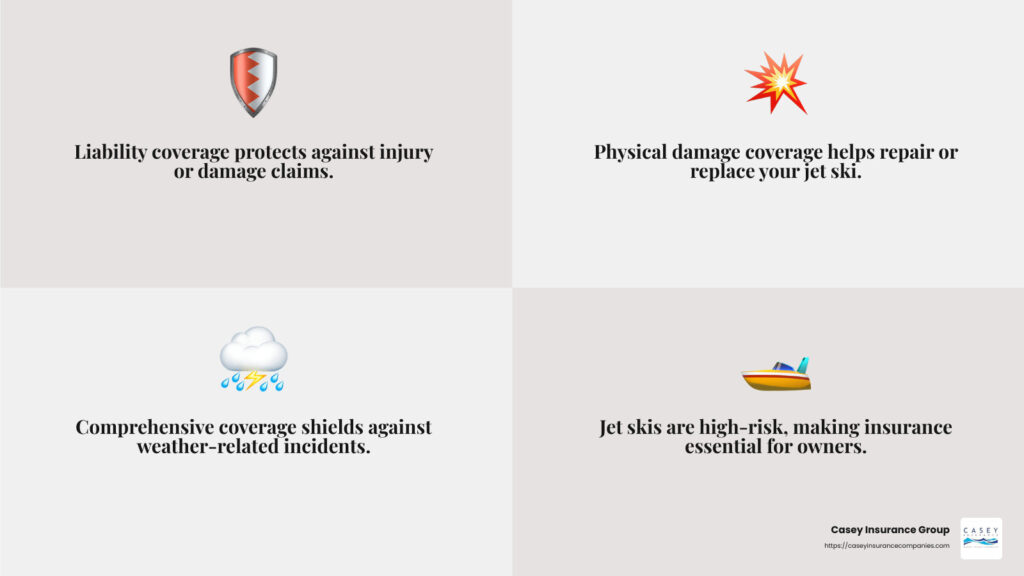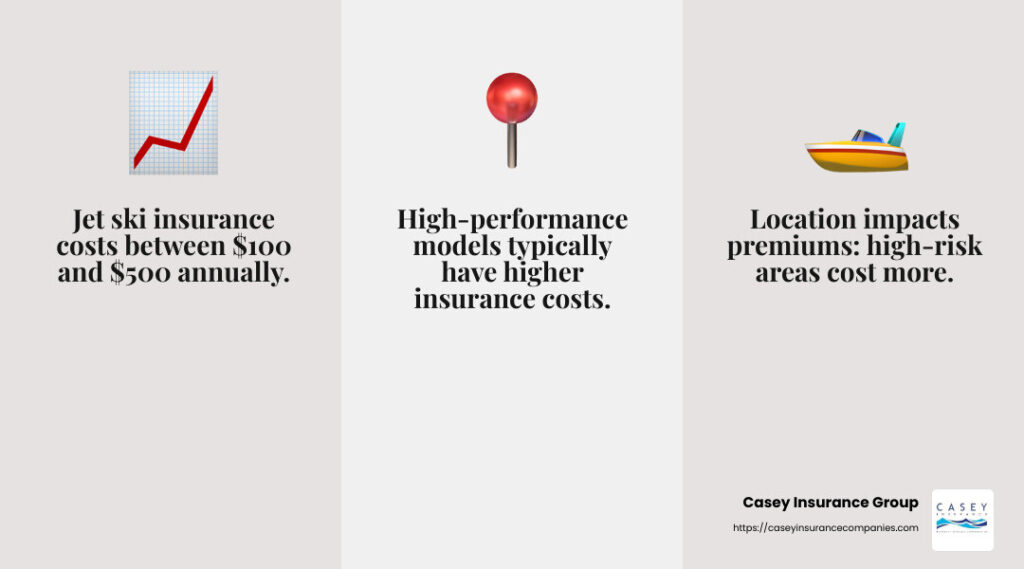Wondering about the jet ski insurance average cost in the US? At Casey Insurance Companies, we provide clear insights: annual premiums typically range from $100 to $500, influenced by factors like your watercraft, location, and chosen coverage. As a leading provider of recreational marine insurance, we’re here to break down what you need to know to protect your investment and enjoy the water worry-free.
Owning a jet ski can offer excitement and trip, but it also comes with risks. Water accidents aren’t rare, and repair costs can be significant. That’s why having jet ski insurance is crucial. From covering physical damage to liability, insurance safeguards your financial interests. As with any personal watercraft, securing the right insurance means you can enjoy your time on the water without worrying about potential mishaps or financial losses.
As the founder of Casey Insurance Group with over two decades of experience, I have guided many in understanding the complexities of marine insurance, including the jet ski insurance average cost. Let’s dive deeper into why protection is vital for personal watercraft enthusiasts.

Understanding Jet Ski Insurance
Jet ski insurance, also known as personal watercraft (PWC) insurance, is essential for anyone who owns and operates these thrilling machines. While jet skis provide fun and excitement on the water, they also come with significant risks. That’s where insurance steps in, offering peace of mind and financial protection.
PWC Insurance: The Basics
PWC insurance is designed to cover various aspects of owning a jet ski. It typically includes:
- Liability Coverage: This is crucial. It protects you if you’re responsible for an accident that causes injury to others or damages their property. Imagine accidentally colliding with another watercraft or a dock. Without liability coverage, you could be paying out of pocket for repairs and medical bills.
- Physical Damage Coverage: This part of the insurance takes care of your jet ski itself. No matter it’s a collision, theft, or vandalism, physical damage coverage helps repair or replace your watercraft. Given the high speeds and adventurous nature of jet skiing, having this coverage is a smart move.
- Comprehensive Coverage: Beyond accidents, comprehensive coverage can protect against non-collision-related incidents like severe weather or fire. If your area is prone to storms or flooding, this could be a lifesaver.

Why Liability Coverage Matters
Liability coverage is especially important for jet skis due to their high-risk nature. According to the local US regulations, personal watercraft like jet skis were involved in 22% of all reported boating accidents in 2020. With multiple riders often on board, the risk of injury increases. Liability insurance can cover medical expenses and legal fees if you’re sued for an accident.
Protecting Against Physical Damage
Jet skis are not cheap, and repairs can be costly. Physical damage coverage ensures you aren’t left footing a hefty bill if your jet ski is damaged. If it’s a minor scrape or a major repair in any case having insurance means you can get back on the water faster without breaking the bank.
PWC insurance is not just a smart investment; it’s a necessary one. It covers the unexpected and allows you to enjoy your water trips worry-free.
Jet Ski Insurance Average Cost
When it comes to Jet Ski Insurance Average Cost, you can expect to pay between $100 and $500 annually. This range can vary significantly based on several factors. Understanding these can help you select the right policy at a price that fits your budget.
Factors Affecting Cost of Jet ski Insurance
- Make and Model: The type of jet ski you own plays a big role. High-performance models or those with more horsepower often cost more to insure.
- Location: Where you operate your jet ski matters. Areas prone to severe weather or high theft rates might lead to higher premiums.
- Boating History: Your experience and accident history can impact your insurance cost. A clean record often results in lower premiums.
- Coverage Level: Opting for liability-only coverage is cheaper than comprehensive plans that cover theft, vandalism, and weather damage.
- Deductible Choices: A higher deductible can lower your premium, but it means you’ll pay more out-of-pocket if you file a claim.
Deductible Options
A deductible is what you pay before your insurance kicks in. For jet ski insurance, deductibles can range from $250 to over $1,000. Choosing a higher deductible can reduce your annual premium, but consider your financial situation. Can you comfortably cover that amount in case of an accident?

Balancing your deductible and coverage needs with your budget is key to finding the best insurance option. As we explore further, we’ll dive into the specific coverage options that can tailor your policy even more to your needs.
Coverage Options for Jet Ski Insurance
When choosing jet ski insurance, understanding the different coverage options is crucial. Here’s a breakdown of the main types of coverage you might consider:
Liability Coverage
Liability coverage is essential for any jet ski owner. It protects you if you cause damage to someone else’s property or accidentally injure someone while operating your jet ski.
Collision Coverage
Collision coverage is like having a safety net for your jet ski. It helps pay for repairs if your jet ski is damaged in an accident, whether it’s with another watercraft or an object like a dock. This coverage is vital if you want to avoid hefty repair bills after an unexpected mishap on the water.
Comprehensive Coverage
Comprehensive coverage offers protection beyond collisions. It covers non-collision incidents like theft, vandalism, and weather-related damage. If a storm or fire damages your jet ski, comprehensive coverage can help with repair or replacement costs. This type of coverage is especially important if you store your jet ski in areas prone to severe weather.
Medical Payments
Medical payments coverage is designed to cover medical expenses for you and your passengers if you’re injured in a jet ski accident. This coverage kicks in regardless of who is at fault, providing peace of mind that medical bills won’t become a financial burden after an accident.
Roadside Assistance
While jet skis don’t operate on roads, roadside assistance is a valuable add-on for those who transport their jet skis via trailer. This coverage can help with towing services for your trailer and towing vehicle if they break down, ensuring you’re not stranded far from the launch.
Having a clear understanding of these coverage options can help you tailor a policy that fits your needs and provides the protection you require. Next, we’ll explore the factors that can influence the cost of jet ski insurance, helping you make informed decisions about your coverage.
Factors Influencing Jet Ski Insurance Costs
When it comes to jet ski insurance average cost, several factors can impact what you’ll pay annually. Here’s a closer look at the key elements that insurers consider:
Age and Location
Age plays a significant role in determining insurance costs. Younger jet ski operators are often seen as higher risk, which can lead to higher premiums. As you gain more experience, you may find your rates decrease.
Location matters too. If you live in an area prone to severe weather, like hurricanes or floods, expect higher insurance costs. Insurers also consider local accident rates, so areas with more watercraft accidents might have higher premiums.
Boating History
Your boating history can influence your insurance rates significantly. If you have a clean record with no prior accidents or claims, you might qualify for lower rates. On the other hand, a history of accidents or claims can increase your premiums, as it indicates higher risk to insurers.
Safety Courses
Completing safety courses can be a smart move. Many insurance providers offer discounts to those who have taken certified boating safety classes. These courses demonstrate your commitment to safe boating practices, which can lower your perceived risk and, consequently, your insurance costs.
Deductible Choices
Your choice of deductible can also affect your insurance costs. A higher deductible generally means lower premiums, but it also means you’ll pay more out of pocket if you file a claim. It’s essential to balance the upfront savings with the potential cost if an accident occurs. Choosing the right deductible depends on your financial situation and comfort with risk.
Understanding these factors can help you manage your jet ski insurance expenses effectively. Next, we’ll address some frequently asked questions about jet ski insurance, providing more insights into its value and coverage.
Frequently Asked Questions about Jet Ski Insurance
Jet ski insurance provides essential protection for both your watercraft and your finances. Without insurance, you could face hefty repair bills or even legal costs if you’re found liable for damages or injuries. Liability coverage is particularly important. It protects you if you accidentally cause damage to someone else’s property or injure someone while using your jet ski. In some states, having liability insurance is not just smart, it’s required by law.
Jet ski insurance is designed to cover a wide range of incidents.
Accidents
Vandalism
Weather damage
Some policies also offer extras, like medical payments for injuries and roadside assistance if you need help transporting your jet ski.
There are several ways to potentially reduce your insurance premiums:
Discounts: Bundling your jet ski insurance with other policies, like home or auto, can lead to savings.
Safety courses: Completing a boating safety course can not only improve your skills but also earn you a discount on your insurance.
Multiple PWC policies: If you own more than one personal watercraft, consider insuring them under the same policy.
By taking advantage of these cost-saving measures, you can ensure that your jet ski insurance remains affordable while still providing the protection you need.
Insuring a jet ski rental business is significantly more complex and expensive than personal jet ski insurance, as it involves commercial risks. Costs for a jet ski rental business can range broadly, often from $3,000 to $20,000+ annually, depending on factors like fleet size, location, liability limits, and specific coverages
Conclusion
At Casey Insurance Companies, we believe that insuring your jet ski is not just about protecting a piece of equipment; it’s about safeguarding your peace of mind and financial security. Our personalized service ensures that you receive a jet ski insurance policy custom to your unique needs, whether you’re cruising the lakes of the Midwest or the coastal waters of the Caribbean.
We understand that every jet ski owner has different requirements. That’s why we offer comprehensive solutions that cover everything from liability protection to coverage against theft, vandalism, and severe weather. Our policies are designed to give you the flexibility and confidence to enjoy your time on the water without worry.
With our expertise in marine insurance, we are dedicated to helping you steer the complexities of jet ski insurance. Our team can guide you in selecting the right coverage options and finding potential discounts to keep your premiums affordable.
If you’re ready to explore how Casey Insurance Companies can provide the best protection for your personal watercraft, visit our personal to get started. Let us help you ride the waves with confidence, knowing that your investment is well-protected.




